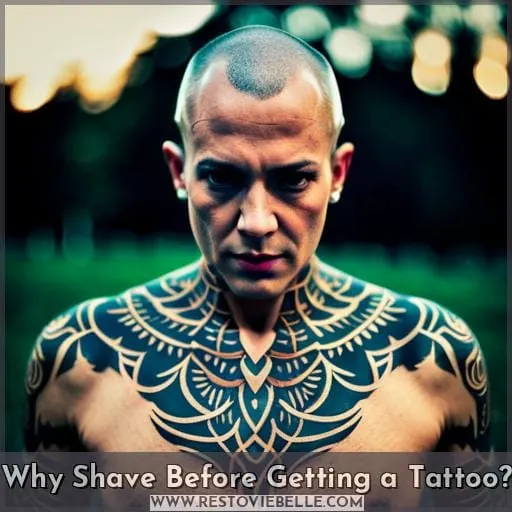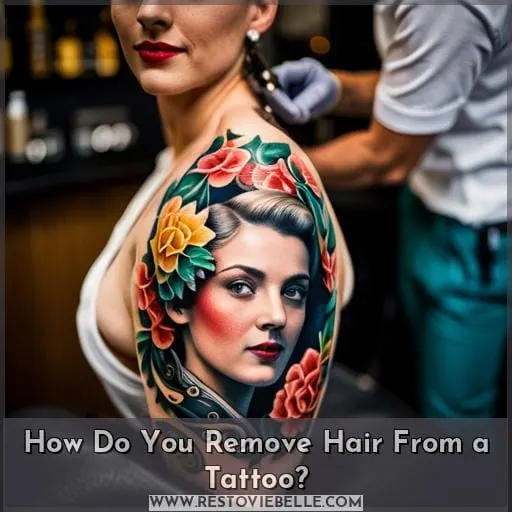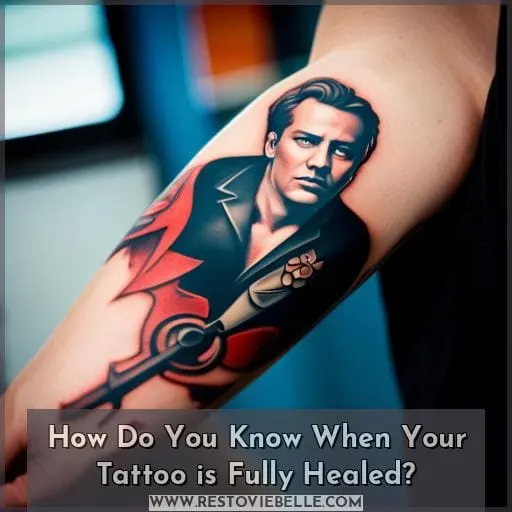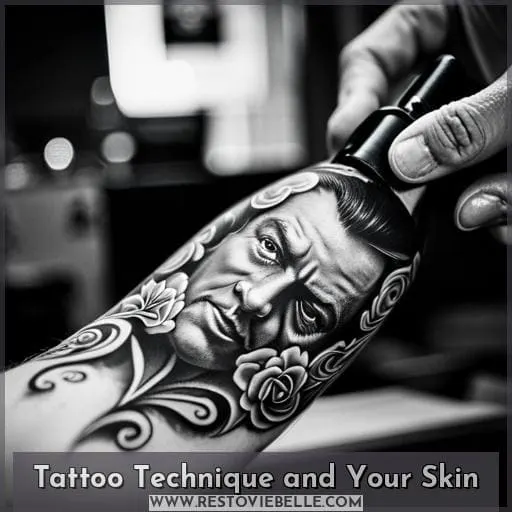This site is supported by our readers. We may earn a commission, at no cost to you, if you purchase through links.

In this article, we’ll explore whether or not hair grows back after getting a tattoo. We’ll also discuss what kind of techniques should be used for removing existing hairs before the procedure and how to know when it’s fully healed.
Don’t let your fear of ingrowns stop you from turning your body into an art gallery – read on to find out all there is to know about tattoos & hair!
Table Of Contents
Key Takeaways
- Tattoos do not affect hair follicles.
- Wait a month after tattooing before attempting hair removal.
- Shaving, waxing, electrolysis, and other hair removal methods can be used post-tattoo.
- Hair will not grow thicker over tattoos.
Will Hair Grow Back Over a Tattoo?
Your tattoos won’t stop your hair from growing back, so it’s best to wait until they’re fully healed before taking any action. Proper skin prep is essential for avoiding ingrown hairs as well as ensuring the healing process goes smoothly.
It is recommended to wait a month after getting a tattoo before attempting any kind of hair removal such as shaving or waxing, and even longer for electrolysis or laser removal. Hair follicles are located below the dermis layer where tattoo ink penetrates; thus tattoos don’t affect them nor their growth.
After some time has passed since getting inked, you may notice that hair grows over your tattooed area within weeks but with its normal texture rather than thicker than usual – this is an illusion created by blunt ends when shaving! Dry skin can also make details of your artwork less visible and exfoliating through regular shaves can help bring out those lines again while keeping everything looking fresh and vibrant!
Why Shave Before Getting a Tattoo?
Shaving before getting a tattoo is essential for having the best results. It’s important to ensure that your skin is properly prepped and ready for the procedure in order to avoid infection while getting your new ink.
Not only does shaving help with stencils applying easier, it also helps create a smoother canvas so that you get clearer lines when you have finished healing up. During this time of healing, there are aftercare tips such as avoiding picking at any ingrown hairs or irritating the area which can cause further complications down the line if not taken care of accordingly.
Shaving isn’t just about creating an even surface but also ensuring good hygiene practices are being followed during and after a tattoo procedure since hair removal can cause bacteria buildup on top of already irritated skin from all needles involved in tattoos.
When looking into other forms of hair removal options like waxing or electrolysis, be sure to wait until well within two months post-tattoo since these methods could potentially damage fresh ink causing fading over time instead allowing proper healing first before going through with another body modification process.
With patience and knowledge, one should be able to finally find out what works best for them regarding their own wants, needs, and comfort levels when choosing how they want to remove unwanted hairs without sacrificing their freshly done tattoos.
How Do You Remove Hair From a Tattoo?
Removing hair from a tattoo can be done in multiple ways, such as electrolysis, tweezing, shaving, waxing, and depilatory creams. Each method has its advantages and drawbacks; for instance, electrolysis is effective but slow, while shaving exfoliates the skin to make the tattoo look better.
It’s important to choose an appropriate removal technique depending on your individual needs.
Electrolysis
Electrolysis is the safest way to remove individual hairs without damaging your tattoo. It works by targeting small areas of skin with an electric current, destroying hair follicles and preventing regrowth.
Detailed healing during post-tattoo care ensures ink deposition remains intact in skin layers while hair texture normalizes over time. Laser removal should be avoided due to potential damage caused by heat near tattoos, but electrolysis provides a safe alternative for detailed hair removal around tattooed areas if done correctly with proper skin prep beforehand.
Tweezing
Tweezing is a slow and painful process, but it can be effective in removing individual hairs without damaging your tattoo. Avoid irritation by waiting until after the healing process to tweeze. Taking proper post-tattoo care prevents ingrown hairs, which can cause pain or infection if not removed safely.
Timing considerations should also factor into laser hair removal decisions as well.
Shaving
Carefully exfoliating the area around your tattoo can help reveal its details and enhance its appearance. Shaving: 1) Manage ingrown hairs; 2) Avoid laser removal near tattoos; 3) Wait for proper healing before shaving; 4) Tattoo needles don’t affect hair follicles below the dermis; 5) Skin prep aids in healing before, after shaving, and tattooing.
Exfoliate cautiously for optimal results! Timely removal of unwanted hair helps maintain a beautiful canvas with intricate ink designs, free from irritation or infections.
Waxing
Waxing may be a longer-lasting solution, but wait a few months after your tattoo has healed. Understand the healing process and follow any aftercare tips to minimize pigmentation change or scarring risk.
Waxing can safely remove hair over tattoos; laser removal should be avoided due to potential risks. There are many other hair removal methods that don’t threaten laser safety or cause ingrown hairs post-tattoo.
Depilatory Creams
Depilatory creams can be an option for sensitive skin, but wait a few months after your tattoo session. Avoid laser removal and perfumed lotions during the healing process to prevent ingrown hairs or blank spots.
Tattoo needles don’t cause hair loss, nor do they interfere with stencil positioning while avoiding damage to follicles below the dermis level.
How Do You Know When Your Tattoo is Fully Healed?
After removing any unwanted hair around the tattooed area, you should wait at least a month before considering any additional hair removal methods such as waxing or electrolysis.
During this time, it’s important to pay close attention to signs that your tattoo has fully healed and take special care of your skin during healing. Tattoo aftercare involves proper hydration and rest, while also preventing ingrown hairs from forming with gentle cleansing techniques.
To ensure optimal results for both the tattoo’s appearance and the health of the skin, prepare ahead by researching laser removal timing tips, tattoo recovery timelines, and other helpful resources about both tattoos and skin healing.
Common signs that indicate full healing are reduced itching sensation on the tattooed area, diminished pain/irritation in injected areas, and loss of scabbing or peeling.
After sufficiently recovering from the original procedure, these indicators will appear naturally without needing further intervention.
Tattoo Technique and Your Skin
Shaving is a great way to exfoliate the skin and bring out your tattoo’s details. But it also has an important role in proper care for a new tattoo. Tattoo artists use shaving as part of their technique when prepping the area, which helps them with ink placement in the skin.
The process doesn’t have any impact on hair follicles, so they remain safe beneath the dermis layer of skin untouched by needles or other tools used during application.
When removing hair over a fresh tattoo, there are some things to keep in mind that will help avoid infection and irritation. It is important to wait until after healing before waxing or electrolysis treatments – usually at least 4-6 weeks post procedure.
Most importantly, let your body heal before attempting any form of removal if possible.
Frequently Asked Questions (FAQs)
Will Shaving Increase the Risk of Infection During a Tattoo?
No, shaving does not increase the risk of infection during a tattoo. Proper preparation and care are key for successful healing, but shaving doesn’t affect hair follicles or cause infections.
Can I Get a Haircut After Getting a Tattoo?
Yes, you can get a haircut after getting a tattoo. However, wait until it’s healed and take care to use sharp scissors and avoid tugging at the skin around the tattoo. To prevent infection, consider shaving with an electric razor instead of cutting hair too close to your new ink.
What Should I Expect in Terms of Color Retention Over Time?
Over time, the color of your tattoo may fade or become distorted. To maintain its vibrancy, you must protect it from UV rays and take care to keep it moisturized. Keep in mind that regardless of how well you care for your tattoo, some fading is inevitable over long periods of time.
Can I Tan After Getting a Tattoo?
You can tan after getting a tattoo, but it’s important to take extra care of your skin. Wait until the tattoo is fully healed and use sunscreen when exposed to sunlight.
Is It Safe to Get a Tattoo During Pregnancy?
Pregnancy isn’t a time to take risks. It’s best not to get tattoos while expecting, as the body is more sensitive and you may be at risk of infection. Consider waiting until after giving birth to ensure safety and peace of mind. Research your artist carefully before committing.
Conclusion
Having a tattoo can be a fun and meaningful way to express yourself, but you should always make sure you’re properly prepared for the process. From proper skin preparation to deciding how to remove hair from a tattoo, there are many important considerations to keep in mind.
Whether you’re getting ready for your first tattoo or adding another piece to your collection, understanding how hair growth interacts with tattoos is essential for achieving the best results.
Tweezing, shaving, waxing, electrolysis, or depilatory creams can all be used to remove hair over tattoos, but timing and technique are important. While there is no risk of hair growing thicker over a tattoo, you should always wait until the tattoo is fully healed before engaging in any hair removal methods, as this can cause irritation and infection.
No matter your experience level, doing your research and finding the right tattoo artist can make all the difference when it comes to achieving the look you want. So, when it comes to the question of does hair grow over a tattoo, the answer is no.











